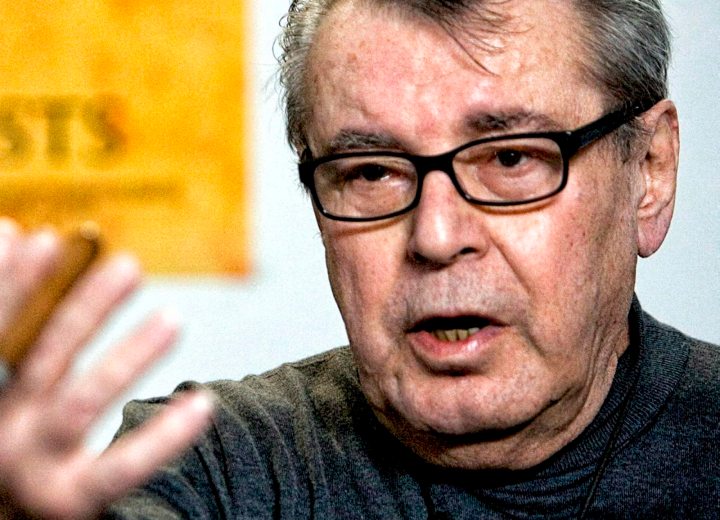Miloš Forman (1932-2018)
One of a kind Czech film genius who enriched the world

Miloš Forman was a filmmaker who treasured the ideas of free expression and liberty and whose politics sent him to Hollywood where he ended up creating some of the most enduring classics.
There is a story about a not-yet-famous film director at a Hollywood party, just before World War II, who had turned to another more famous director, supposedly Michael Curtiz, for solace when the new kid on the block had realised he could barely understand anything anybody else was saying at the gathering. Asked for advice, Curtiz reportedly told him, “Learn to speak Hungarian like everybody else in Hollywood!”
Whether or not it is a true story, nevertheless it illuminates a deep truth about Hollywood. Largely founded by immigrants and first-generation entrepreneurs (including an immigrant scrap dealer or two) who had few illusions about whether what they were doing was making art, since its inception as a centre for filmmaking, Hollywood and its industry have been a magnet for foreign directors, screenwriters, soundtrack composers, and actors, all eager to make their mark at that big show, and to bring their artistry to the big screen.
Director Miloš Forman, who passed away, aged 86, on 13 April, was yet one more of those illustrious migrants who made the American film industry their own. And, in doing so, he created enduring works that spoke clearly about his love of and desire for creative freedom of expression. (Just by the way, the Japanese filmmaker, Isao Takahata, also passed away a few days ago, on 5 April at the age of 82. Together with filmmaker colleagues, he had created Studio Ghibili and its trademark anime that drew upon influences as varied as mainstream animation traditions, Japanese ukiyoe woodblock prints, and manga graphic novels, in order to create a globally respected and popular run of films that included the classic of the genre, Grave of the Fireflies. Given his importance and that of his studio in world cinema, Takahata actually deserves his own article.)
Born on 18 February 1932, in the then-Czechoslovakia, with his early films Forman first attracted international attention with his films, Black Peter (1964), The Loves of a Blonde (1965) — an Oscar nominee for best foreign-language film — and The Firemen’s Ball (1967). Given its sly but stinging critique of Czech government and society, this latter film garnered serious governmental sanction from the then near-Stalinist regime in Prague.
Forman, the youngest of three brothers, became an orphan after their parents were killed in Auschwitz. Accordingly, he spent much of his youth in a boarding school set up for war orphans. (He eventually learned that his real biological father – with whom his mother had had an affair – had actually escaped wartime Europe and had ended up in Peru where Forman made contact with him later in life.)
About his parents, Forman would later write in his autobiography,
“My parents were real patriots, and that was probably the reason why they died. Not until much later, when I was suddenly far from my homeland and its culture, far away from my family, when I was cut away from the land of my childhood, I realised I shared this strong feeling of affection for my country with them.”
In the early 1950s he became a student at the newly formed Film Institute of the University of Prague – a place that became the launching pad for a group of young and talented filmmakers who, collectively, became the leaders of the “Golden Age of Czech Cinema”.
Following his graduation, Forman made several short documentaries, then Black Peter and The Loves of a Blonde, both largely autobiographical. As Forman said later about those works:
“When we started to make our films, they were really Czech films about Czech society and Czech little people — and who cares about Czech little people? So it was satisfying to have people in other countries respond.”
His humour and an anti-establishment sentiment came together in his next work, The Fireman’s Ball. With its not so thoroughly veiled criticism of the country’s bureaucracy, powerful politicians had it banned after the Soviet invasion of August 1968 that had ended the Prague Spring. Fortunately for Forman, at that particular time, he happened to be in Paris where he was in negotiations for his next production, Taking Off, a US film project about the counterculture and protest movements. With his own nation now under a deeply repressive regime, he decided to emigrate to the US, rather than return home.
Taking Off, however, did spectacularly poorly financially, and in coming to terms with this failure Forman used to joke that by the time the accounts were finally wrapped up, he ended up owing $500 to the studio, Universal, that had been involved in the project. Taking Off had featured people like Buck Henry, Ike and Tina Turner, Carly Simon and Kathy Bates – and while it was a financial catastrophe, it eventually gained an enthusiastic, countercultural audience and, perhaps most important of all, it helped keep Forman’s name alive as a director for future projects.
Less than a decade after his move to the US, Forman was tapped by Michael Douglas, one of the co-producers of a slow-gestating project, to be the director who would turn Ken Kesey’s 1962 wild, anarchic cult novel, One Flew Over the Cuckoo’s Nest, into a major studio film. Back then, Michael Douglas, then a University of California, Santa Barbara student, had become an admirer of Forman’s previous film work, and so the deal was struck.
Intriguingly, Forman eventually learned that Michael Douglas’ father, the A-list star and sometime producer Kirk Douglas, had actually sent him an offer to direct the film way back in the 1960s, but since he never received it, it probably had been confiscated by the Czech secret police.
In Firemen’s Ball, “Milos juggled all these multiple characters so well,” Michael Douglas once said, “and he brought out the foibles and the vulnerabilities and the humour within them, without laughing at them. And I think that’s the essence of Cuckoo’s Nest too.”
Starring Jack Nicholson and Louise Fletcher, along with a superb cast of supporting actors, the 1975 film became a popular and critical sensation, and it garnered a whole clutch of Academy Awards, including best picture, best director, best actor, best actress and best adapted screenplay. This memorable film portrayed the tyrannical goings-on in a state mental hospital in which the newest inmate, McMurphy, led a surreptitious, sometimes below-the-radar patients’ revolt until he is finally cowed into submission with an involuntary pre-frontal lobotomy.
His next big work was Hair, in 1979, based on the popular countercultural Broadway musical, and then the film treatment of EL Doctorow’s novel, Ragtime, in 1981. The latter film, set in the New York City of the early 1900s, featured a mix of real historical and imaginary characters, and the cast included James Cagney in his last role on screen. Ragtime was nominated for eight Oscars, but failed to gain any statues.
He also appeared on screen as an actor in a small role in the 1986 film Heartburn that was directed by yet another of those successful European émigrés turned major Hollywood directors, Mike Nichols. And that film also included Jack Nicholson in its cast.
Three years later, he wrote and directed the Colin Firth/Annette Bening vehicle, Valmont, an adaption of the 1782 novel, Les Liaisons Dangereuses. However, since Forman’s film had come out so soon after another hit film based on the same book, critics and audiences were not as kind to Forman’s newest film as they had been to his biggest hits.
Nine years after Cuckoo’s Nest, Forman then had a second golden moment with the film, Amadeus, starring Tom Hulce as Wolfgang Amadeus Mozart and F Murray Abraham as competitor composer Antonio Salieri. It raked in 11 Oscar nominations and eight wins, including those for best picture and director. The film depicted Salieri’s conscience-stricken agonies, as he cannot atone for his ill-treatment of Mozart as a person and envy of him for his genius – essentially given Mozart’s loutish manners and totally irrepressible spirit.
In an interview published some 15 years ago, Forman had described his initial intersection with Amadeus, explaining that he had accepted an invitation to see a new play in London, not realising it was the first public preview of Peter Shaffer’s newest work, Amadeus.
As he explained the circumstances:
“I was used to seeing the Russian and Czech films about composers, and they were the most boring films. Communists love to make films about composers, because composers compose music and don’t talk subversive things. And I am sitting in the theatre waiting to fall asleep, and suddenly I see this wonderful drama, which would be wonderful even if it was not Mozart and Salieri. … I was glued to the seat to the very end. And right there after the show, I met for the first time Peter Shaffer, and I told him that if he would ever consider making a movie, I would be very interested.”
In the end, it became a smash success with audiences and critics, and Forman filmed most of the work in his native country in order to get the authenticity of those buildings and interiors from the old Habsburg-era locations.
Later in life he did two additional critically applauded films, The People vs Larry Flynt in 1996, and then three years later, the film that profiled the tormented life of television actor/comedian Andy Kaufman in Man on the Moon. Forman was again nominated for an Oscar for the Larry Flynt story – a tale of US Constitution First Amendment rights under threat. Intriguingly, Forman and his third wife’s twin sons were named Andrew and James after Andy Kaufman the character and Jim Carrey, the actor who had portrayed Kaufman in the film.
In addition to his directorial work, Forman had served as a professor of film and co-chair of the film division of Columbia University’s School of the Arts, and he had authored his autobiography, Turnaround. While his output was not as vast as some directors, works like Cuckoo’s Nest and Amadeus have become modern classics, both for their cinematic splendour, as well as for their philosophical and ideological support for the ideas of human dignity and artistic freedom.
Or as Directors Guild of America president Taylor Hackford had said of Forman:
“No matter what subject or genre he tackles, Miloš finds the universality of the human experience in every story, allowing us – his rapt audience – to recognise ourselves within the struggle for free expression and self-determination that Miloš so aptly portrays on the silver screen.”
Indeed. DM
Photo: US film director Milos Forman speaks about his film Goya’s Ghosts during a photo call at Gothenburg Film Festival, 02 February, 2007 in Gothenburg Sweden. EPA/Adam Ihse

















 Become an Insider
Become an Insider